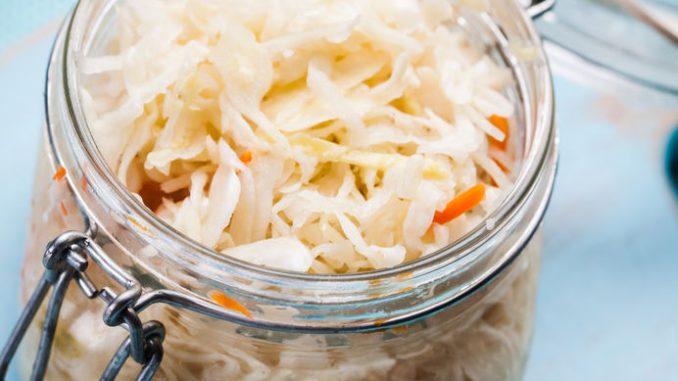
- How to make that well known classic the fermented cabbage dish known as sauerkraut at home.
Sauerkraut or ‘sour cabbage’ in German is much better known than kimchi at the moment even though this Korean fermented dish is grabbing all the limelight. Across the border in Alsace, France there is a very similar type of fermented cabbage food called choucroute.
Historically, sauerkraut began in China even though it is more closely associated with Germany. It is said that construction workers on the Great Wall in 600 A.D. lived on nothing but rice and cabbage. Naturally, cabbage was eaten fresh in the summer months but come the colder months, they had to rely on preserved foods fermented in rice wine. Whilst fresh cabbage has a high vitamin C content, it was improved through fermentation in the form of sauerkraut.
The Tartars brought this food into Europe where it was cured with salt rather than rice wine. This is the forerunner of sauerkraut. It was also sustenance for naval fleets especially in Britain. It helped combat scurvy alongside limes and lemons. The Scottish doctor, James Lind recognised its value and it fed Captain Cook’s crew from 1764 onwards.
In modern cooking it is essential fare with hot dogs and bratwurst or beef sandwiches.
All these foods including kimchi need to be eaten when they are ‘live’.
Preparation time: 30 – 45 minutes
Fermentation takes between 5 days-5 weeks
Makes 1 large jar
Ingredients
1 medium white cabbage (about 1kg)
1 tbsp fine salt
1 tsp juniper berries or caraway seeds (optional)
The first requirement is to find a decent enough sized green cabbage. generally, any will do but we prefer the firmer ball types such as Greyhound or Hispi. Other like a kale or Savoy cabbage have leaves which are too flabby and limp for this type of dish.
Some people have used red cabbage which can be made more north European by adding spices and juniper berries to create a unique flavour.
Remove any outer leaves that may be damaged or dirty.
Shredding the Cabbage
Traditionally, cut the cabbage into quarters and take off the stem which is usually a wedge at the bottom of the cabbage. Shred the cabbage with a sharp knife.
Some people use a food processor with a slicer to generate thin strips. I do not find a mandoline suitable because it doesn’t really produce the level of cut needed.
Adding Salt
The shredded cabbage is placed in a large bowl to which is added salt. Toss the whole lot and make sure the salt covers the shredded leaves evenly and thinly. Don’t be too kind here as with kimchi it needs to be well covered which is where the hand mixing comes in. It’s a bit like kneading pastry to be honest.
The salt draws out moisture so there should be some watery liquid in the bowl after 15 minutes of massaging. Pressing the cabbage will also help express more liquid.
Packing Sauerkraut Into A Large Glass Jar
Put all the cabbage including the salty liquid into a jar. This is the fermenting vessel and ideally should be easily cleaned and see through so that fermentation can be checked.
Metal is to be avoided.
Push the cabbage right down. The shreds should be below the level of the liquid although we have got away with some exposure at the surface. It is effectively a form of semi-solid composting which I know does not sound attractive but that is really what we are relying on.
Add any spices including juniper berries. If you wan to why not try yellow mustard seeds, nigella seeds, onion seeds, dill and parsley. You can add chopped beetroot for colour.
Pressing The Shred
Use fermenting crocks to weight the sauerkraut down. I know some folks use outer cabbage leaves which are usually discarded as a surface layer. It should be big enough to keep the cabbage leaves compressed.
Leave in a dark place at a cool room temperature (about 18-20ºC) for at least five days. The whole mixture needs to breathe. It will be ready to eat after five days, but for maximum flavour leave the cabbage to ferment for anywhere between 2-6 weeks or until the bubbling subsides. The five week period is optimal for flavour creation.
Check from time to time to make sure the shreds are covered with liquid. Some tasting work is needed to monitor sourness and the development of any objectionable odours.
Cover The Jar And Allow To Ferment
Having checked the flavour, just remove any weights. Seal the jar with a tight fitting lid. Store in the refrigerator or somewhere cool where there is no fluctuation in temperature.
Sauerkraut is usually eaten as a side or as part of a salad. There are some who have it as a cooked side with sausages.
Leave a Reply